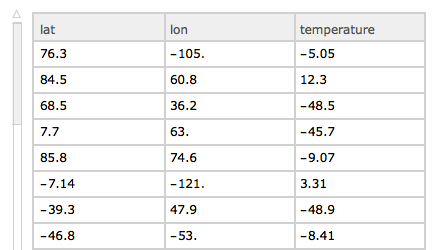I think aardvark2012's answer is correct, this is just a comment on your follow-up questions. Your follow-up questions can be addressed by providing NetTrain with the compatible training data formats.
You can either use a Dataset or a list as training data. If a Dataset is used, then the format should be like Dataset[{<|"Input" -> {64, 25}, "Output" -> -24.8889|>, <|"Input" -> {-49, -101}, "Output" -> -28.0145|>}]. For example
inputdata =
Dataset@Table[
Association["Input" -> RandomReal[{0, 1}, {2}],
"Output" -> RandomReal[{0, 1}]], {10}]

then you can train the network like
net = NetChain[{5, 1}, "Input" -> 2, "Output" -> "Scalar"];
trained = NetTrain[net, inputdata]
If using a list, then the training data should be like {{64, 25} -> -24.8889, {-49, -101} -> -28.0145, {9, -112} -> 22.6383, {-65, 150} -> 13.6052, {25, 110} -> 29.0704}. For example
inputdata =
Table[RandomReal[{0, 1}, {2}] -> RandomReal[{0, 1}], {10}];
net = NetChain[{5, 1}, "Input" -> 2, "Output" -> "Scalar"];
trained = NetTrain[net, inputdata]
You can also specify the input and output ports with NetGraph, which then allow you to train on a Dataset with named keys directly. For example
inputdata = Dataset[Association[Thread[header -> #]] & /@ data]

net = NetGraph[{ReshapeLayer[{1}], ReshapeLayer[{1}], CatenateLayer[],
LinearLayer[5], LinearLayer[1]}, {NetPort["lat"] -> 1 -> 3,
NetPort["lon"] -> 2 -> 3 -> 4 -> 5 -> NetPort["temperature"]}]

NetTrain[net, inputdata, Method -> {"ADAM", "LearningRate" -> 0.01}]
Hope it helps.
Here is an example of how to read in and train on a csv dataset
path =
Export["~/Downloads/test.csv",
Table[{RandomReal[{-90, 90}], RandomReal[{-180, 180}],
RandomReal[{-50, 50}]}, {100}]]
(* "~/Downloads/test.csv" *)
inputdata = #[[1 ;; 2]] -> #[[3]] & /@ Import[path, "Data"];
net = NetChain[{5, 1}, "Input" -> 2, "Output" -> "Scalar"];
trained =
NetTrain[net, inputdata, Method -> {"ADAM", "LearningRate" -> 0.01}]
another example using dataset
path =
Export["~/Downloads/test.txt",
StringRiffle[
Prepend[Table[
StringRiffle[
ToString[NumberForm[#, {3, 4}]] & /@ {RandomReal[{-90, 90}],
RandomReal[{-180, 180}], RandomReal[{-50, 50}]},
"\t"], {100}],
StringRiffle[{"lat", "lon", "temperature"}, "\t"]], "\n"]]
(* "~/Downloads/test.txt" *)
tmp = Import[path, "Table"];
inputdata =
Association["Input" -> #[[1 ;; 2]], "Output" -> #[[3]]] & /@
Rest@tmp;
net = NetChain[{5, 1}, "Input" -> 2, "Output" -> "Scalar"];
trained =
NetTrain[net, inputdata, Method -> {"ADAM", "LearningRate" -> 0.01}]



